Whether you are new to hiking or have been hiking professionally for years, squeaking hiking boots is always an embarrassing and irritating experience. With the rise in online shopping, many people have found themselves in a situation where what they ordered is different from what they got.
Most times, hikers—especially the beginners—will want to ignore the squeak thinking that it would resolve on its own. Sadly, their wish never happens and they will eventually lose their patience.
While some can tolerate the squeaking sounds of hiking boots, for others it is a total turn-off. So, what happens if the boot fits snugly, the price is amazing, and you are drooling over the design? Will the squeaking sound be enough to make you want to throw away the boots?
In other words, are you willing to throw away the child with the bathwater? Guess not. The good news is that there is a way to make that squeak go away and we will walk you right through all the processes.
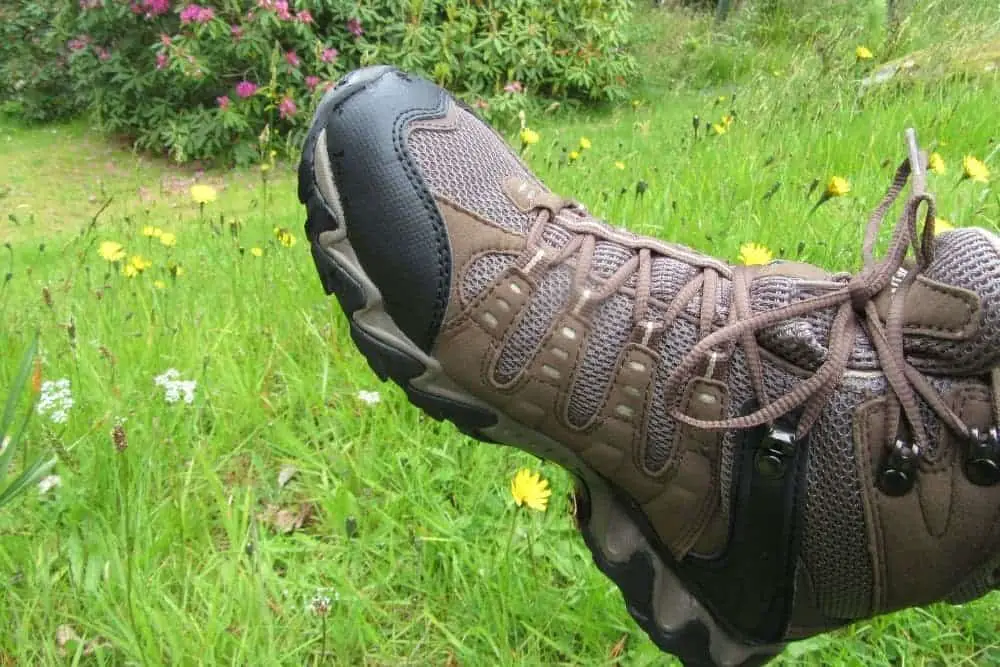
Contents
Why do my hiking boots squeak? And how to stop it!
Different factors can contribute to the squeaking of boots.
In some cases, you may observe that your boots squeak only when you walk on certain surfaces while in other cases the squeaking is consistent irrespective of the surface. At such times, the reason for the squeak is usually because two different parts are rubbing against each other.
Therefore, the first step towards resolving the mystery regarding squeaking hiking boots is to figure out the cause of the squeak and the part of the boot the squeaking is coming from. Once you figure this out, you will be able to apply the right fix to the squeaking area to stop it.
We are going to look at all the areas of hiking boots that are likely to squeak and how to stop each of them. If all the steps we are going to highlight below fails, the next smart move would be to return the boots.
Read more: Why Do My Hiking Boots Stink?
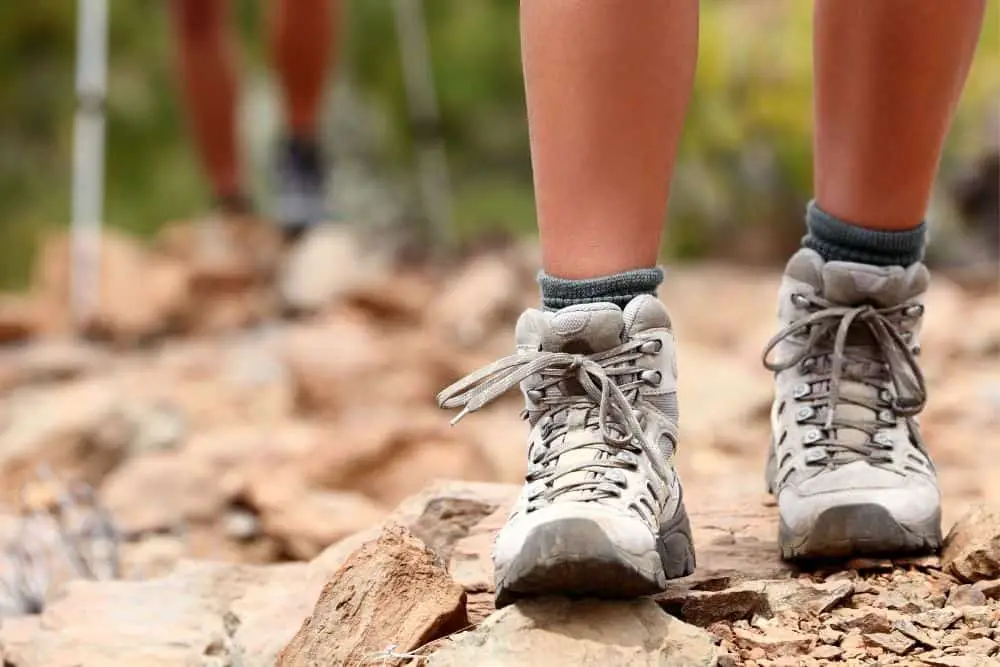
1. Squeaking from slick bottom soles
New boots will almost more likely squeak when you walk on a floor made of hardwood or smooth cement. Thankfully the squeak that happens on the outside of the boot will normally resolve on its own over time as the soles become coarser.
However, if the squeak doesn’t go away after a week or two of break in, it is time to try something different.
To see if the squeak is really from the soles, cover the entire bottom of the soles with duct tape. If the squeak disappears, you have found the source of your headache—and luckily, it is an easy fix.
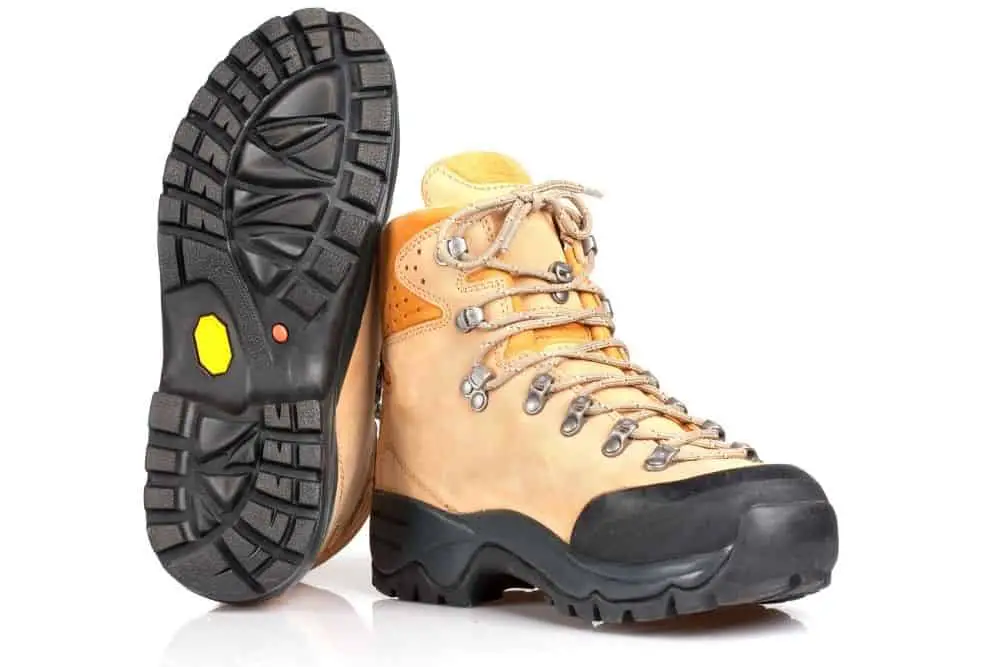
How to prevent and solve squeaks from slick soles
Sadly, you cannot prevent squeaking that comes from the bottom of the soles because the manufacturers decide the type and grip of the soles of your hiking boot.
To increase market appeal, these soles are often polished leaving a glossy finish. This polishing also makes them slick.
- Solution 1
The first thing that you should try is to clean the bottom of the soles. Dampen a clean towel with warm water and wring the excess off the towel.
Rub the bottom of the sole with a damp towel to remove grime and dirt. It mustn’t be spotlessly clean but make sure you remove any thick layer of dirt.
Dry the soles with a clean cloth to further get rid of any residual dirt. Then, run dryer sheets rigorously on the bottom of the soles so that it leaves residue over the entire surface. The residue will reduce the slickness of the soles which should be enough to stop the squeak.
- Protect footwear from water and stains and keep them looking new with this all-in-one suede and...
- Use the concentrated suede cleaner to safely remove dirt and grime from suede, nubuck, canvas and...
- Maximizes breathability of waterproof-breathable shoes to keep your feet feeling cool and dry
Last update on 2023-11-11 / Affiliate links / Images from Amazon Product Advertising API
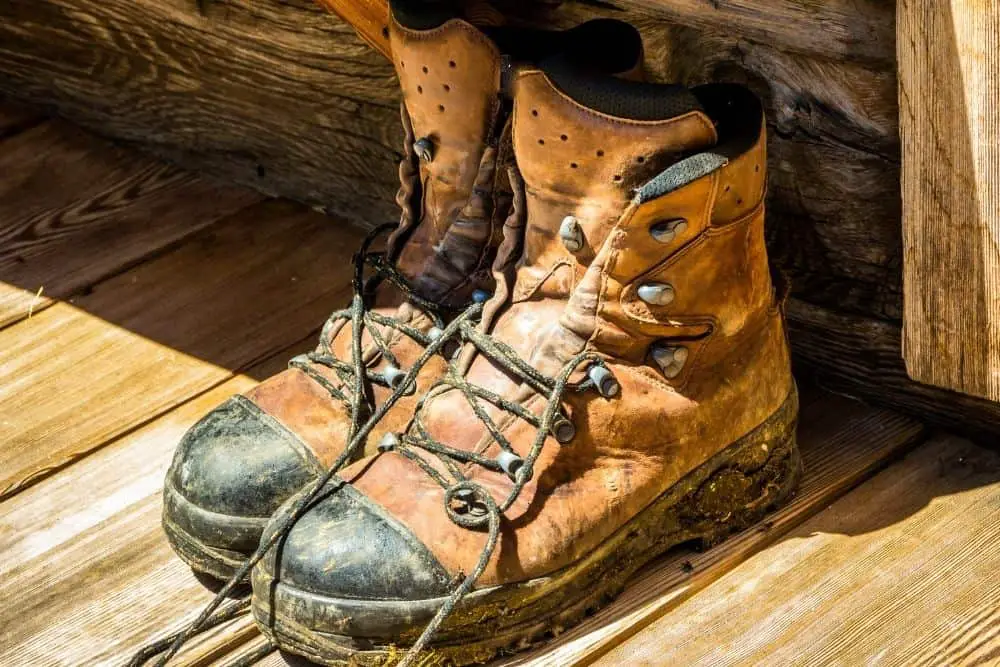
- Solution 2
If your boot still squeaks after trying the first solution, there is something else that you can do. Increasing the friction between the bottom of the soles and the floor can help to reduce squeaking.
You can reduce friction using sandpaper with 60 to 120 grits. Holding the sheet in your palm, gently move around the bottom of the soles to lightly scrape it. The coarse surface created by this will prevent squeaking on smooth surfaces.
- MEETS ALL YOU NEED - Including 3 sheets of each grit:...
- PREMIUM QUALITY - Sandpaper made of waterproof silicon carbide, electro coated ensures the grit...
- EASY TO INSTALL: Sandpaper is fixed by stainless steel clips on both sides of holder, faster and...
Last update on 2023-11-11 / Affiliate links / Images from Amazon Product Advertising API
Scared that the sandpaper will damage the bottom of your soles? There is an alternative. Hiking surfaces with sharp sand, rock pieces, or gravel will achieve the same outcome albeit slower.
Note that if you walk any of these lines, you will modify the bottom of the soles so much that you will not be able to return it. Therefore, only make sure you use lubrication or sandpaper only when you have no intention of returning the boots.
- Solution 3
A lot of people have reported that they were able to eliminate squeaking on hardwood or smooth cement floors using grip spray. As their name implies, these sprays improve grip thereby preventing the boots from sliding—which is usually what leads to squeaking.
- Keep Your Shoes Performing Like New: Performance Grip Basketball shoe spray is designed to clean and...
- Cleans Dirt and Debris: Performance Grip spray for basketball shoes brings the life back to old...
- Non-Sticky Residue: Athletes want to grip the floor, not stick to the floor. Unlike other products,...
Last update on 2023-11-11 / Affiliate links / Images from Amazon Product Advertising API
There is also a traction pad that you can stick to the bottom of the soles. Like the spray, they improve the grip between your sole and the floor.
However, durability has always been a source of concern with traction pads. They seem to work well at first but gradually lose their effect and peel off.
2. Squeaking from insoles
The squeaking can also come from the inside of the boots. This will usually happen as a result of friction between the rubber soles and the insoles. There are two main factors that can cause this friction.
Firstly, if you are wearing a boot that is not the right fit, your feet will slide along the insoles as you move. This causes the insoles to wear out over time leading to a squeaking sound.
Even if the boot is the right fit, squeaking can still occur between the insoles and the rubber soles. This happens more in boots where the insoles are not glued to the rubber soles.

How to prevent and solve squeaks from insoles
The best way to prevent squeaks from insoles is to make sure that you only purchase boots that are the right size for you. If you are shopping online and receive a product that is not your size, the best step is usually to return it.
Another way to prevent squeaking that comes from the inside of the shoe is to glue the insoles to the outsoles which stops it from sliding or rubbing against the sides of your boot to create the annoying sound. Make sure you choose professional grade glue.
- PROFESSIONAL STRENGTH shoe glue that bonds almost instantly with no clamping!
- STRONG FLEXIBLE BOND IN SECONDS. Make your repairs with confidence, Shoe-Fix Glue creates a flexible...
- NO EXPANDING, dries clear, heat, cold, and moisture resistant.
Last update on 2023-11-11 / Affiliate links / Images from Amazon Product Advertising API
- Solution 1
If the squeak starts suddenly after you have used the boot for several weeks or months, it is likely because the insoles have worn out. The best solution to stop the squeak would be to remove the insoles and replace them with new ones.
If the insoles are glued to the outsoles, you may need a sharp tool to pry it out. Fix the new insoles and glue them back to the rubber soles.
The truth is, most of the insoles that come preinstalled in hiking boots are not designed to endure the torture that most of the users put them through. However, there are special gel insoles for heavy hikes. They are designed to support and distribute the weight of people above 200 pounds.
- Specially designed for men over 200 lbs., tall and/or those with wide width feet
- All-day support & relief, every day
- Extra supportive heel cushioning surrounds the heel and relieves lower back pain & leg fatigue
Last update on 2023-11-11 / Affiliate links / Images from Amazon Product Advertising API
Gel insoles are generally designed to be sturdy and anti-slip. Their use limits the chance that the squeak will ever happen. It will be a nice idea to replace the insoles with more suitable ones immediately after you purchase your boots.
- Solution 2
One of the popular quick fixes among hikers that you can apply to stop the squeak is the use of baby powder to reduce friction.
Remove the insoles and apply a thin layer of the baby powder (approximately 2 tablespoons). Rock the boot back and forth to even out the powder before replacing the insoles.

The thin layer of powder will serve as a protective layer between the insoles and the rubber soles. In addition to increasing friction which stops the squeak, the powder can also absorb moisture and sweat thereby providing additional benefits.
If you are making use of this method, you obviously cannot glue back the insoles into position. Also, the effect of the powder wears out in the long run. Therefore, you will need to repeat the process as often as necessary.
3. Squeaking from eyelets, lace, or tongue
Sometimes you may think that the squeaking is from inside of the boot when actually it is from the very top. The part of the boot that is most implicated in this case is either the eyelets, the tongue, or the laces.
The tongue of the boot can rub against the laces or the sides of the boot to cause a squeaking sound. This can happen with new boots but will go away after a few weeks of break-in.
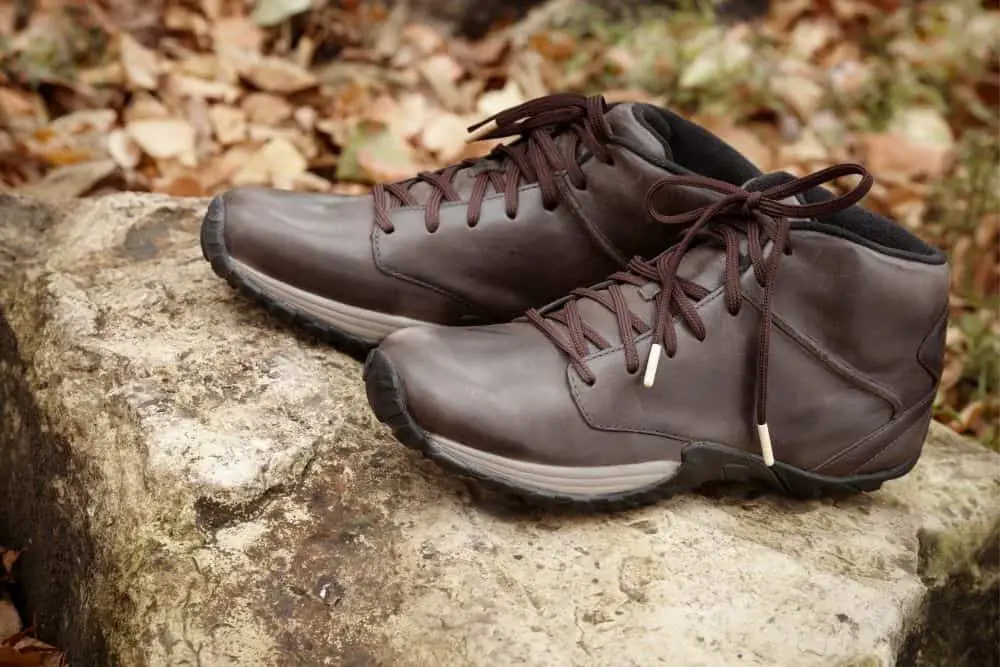
How to prevent and solve squeaks from tongue, lace, or eyelets
Securing the tongue of your boot properly with the laces may be enough to stop the squeak. This will prevent the friction that occurs when you move your feet.
If the squeaking suddenly starts after using the boot for a while, there are steps you can use to silence the noise.
- Solution 1
Saddle soap will do the trick if the squeak is from the lace, tongue, or eyelets. Undo the lacing of your boot and pull them out. They are readily available online and in leather repair shops.
- Fiebing's Saddle Soap is used all over the world on fine saddlery, boots, shoes and other smooth...
- Use this soap to clean not only saddles, but boots, baseball gloves, or any other leather!
- Maintains leather's suppleness and strength while cleaning and lubricating the fibers to prevent...
Last update on 2023-11-11 / Affiliate links / Images from Amazon Product Advertising API
Some saddle soap requires water to activate. In that case, just sprinkle a few drops of water on it. Afterward, dip a clean cloth into the saddle soap and use it to work around the tongue of the boot and the eyelets. Remember, you don’t need a lot of saddle soap to achieve the desired result.
- Solution 2
If you suspect that the squeakiness is generalized rather than localized, you can apply conditioning oil to not only stop the squeak but also to protect and soften the leather.
Make sure you use a conditioning oil that is compatible with the material of your boot. Just like using powder, you may need to repeat this procedure from time to time.
4. Squeaking from wetness
Not all hiking boots are waterproof and those sold as waterproof have their limits. That means that there is a tendency that water can still get into your boots when you hike wet areas or expose the boot to a humid environment.
When the leather of your boot absorbs moisture or the outsoles trap water, they will likely squeak when you walk. Squeaking from wetness is not only embarrassing but can also make you self-conscious. Thankfully, there is a way that you can revert this.
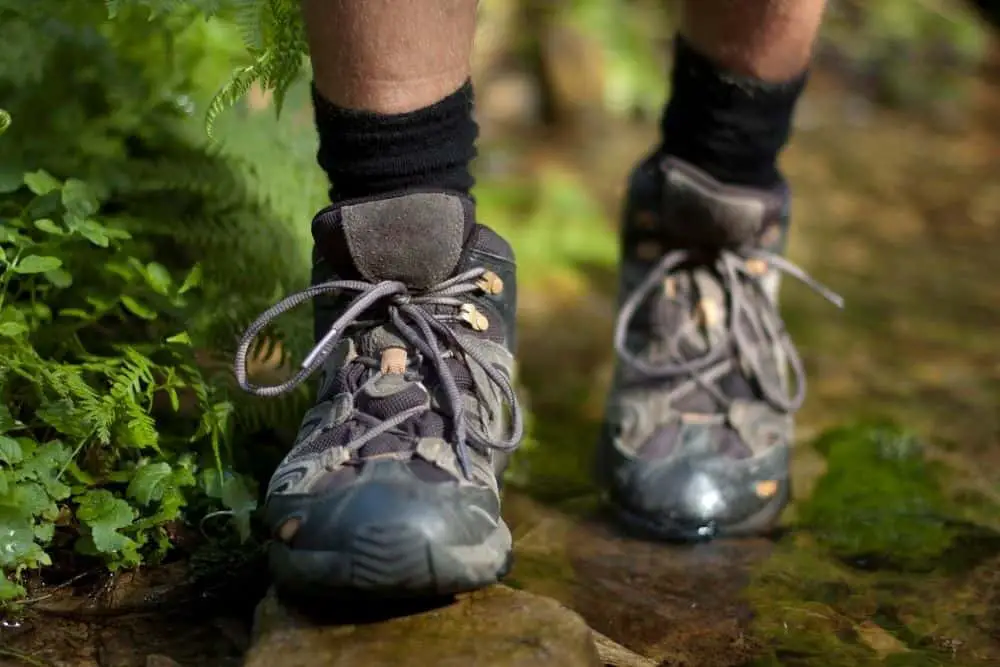
How to prevent and solve squeaks from wetness
The best way to prevent squeaks from wetness is to avoid hiking wet areas in the first place. For this reason, it is important to always check the weather forecast before embarking on any hike. Alternatively, you can decide to restrict your hikes to summer seasons.
If you must hike in wet areas, you can protect your shoe using a waterproof spray. What the spray does is coat your boot (mostly with silicone) which bonds to the leather to create a tough water barrier without affecting the breathability of your leather.
- KIWI Boot Waterproofer provides tough silicone protection for work and outdoor boots
- Waterproof spray for boots
- Spray has unique formula that bonds to leather and fabrics
Last update on 2023-11-11 / Affiliate links / Images from Amazon Product Advertising API
While waterproof spray tends to work, there have been reviews that show that some of them can cause discoloration to certain areas of your boot. Therefore, you have to be mindful of the product you buy, make sure it is compatible with the material of your boot, and stick to the manufacturer’s instructions.
- Solution 1
We know that restricting hikes to certain times of the year is not always possible, especially if you are an avid adventurer. Nevertheless, if you happen to get your boot wet, follow the steps below to dry them out.
Firstly, you should remove the insoles and laces and hang them separately. Then, hang your boots too or place them in front of a fan to help it dry faster.
Also, you can stuff your boot with newspaper to help draw the moisture from the boots. Never attempt to dry your boots close to an open flame or heat source because it will damage the leather of your boots.
- Solution 2
Another highly effective but less explored way of preventing wet boots is to use boot covers. They usually have anti-slip designs which keeps you safe on wet floors while preventing water from getting into your boots.
- Reusable & Washable- Suitable for both hand wash and machine wash.
- Top-quality Material- Made of excellent napped cotton, bright and comfortable, which realizes a...
- Anti-slip Design- Keeps you safe even the floor is wet.
Last update on 2023-11-11 / Affiliate links / Images from Amazon Product Advertising API
If you will be hiking areas with deeper water deposits, use longer boot covers. The shorter covers will work in areas with shallow water.

- Solution 3 (best solution)
In fact, if you have more than one pair of hiking boots and your trips are often in the rainy season, then you should use boot trees to keep hiking boots dry inside and out to avoid mold. A boot dryer is also a very good solution.
Boot Dryer can help many of your hiking boots dry quickly, while boot trees keep your boots in shape and absorb moisture when you put them into your boots.
Last update on 2023-11-10 / Affiliate links / Images from Amazon Product Advertising API
Read more: Can You Use Hiking Boots for Wading?
5. Squeaking from excessive dryness of the leather
Excessive drying of hiking boots is just as bad as having them wet—they will still squeak.
Sadly, if you stay in a desert region where the air is mostly dry, the leather of your hiking boots will lose moisture and dry out.
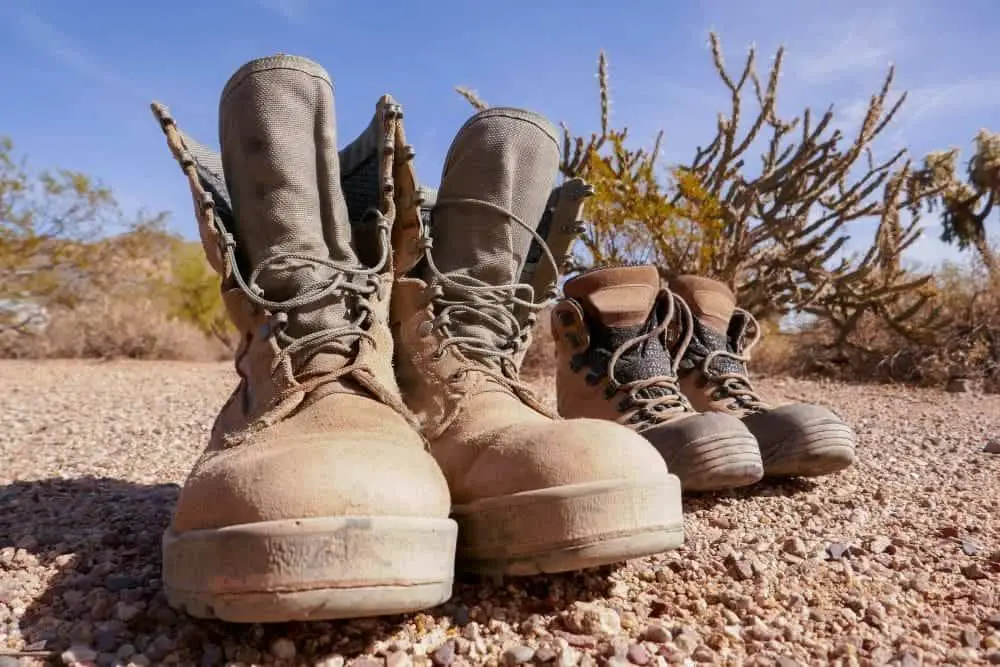
How to prevent and solve squeaks from excessive dryness
The way you store your boots will determine if the leather will get excessively dry or not. Therefore, proper storage practices are what you need to prevent your boots from excessive dryness.
Before storing your shoes, stuff it with newspaper to keep the toe box smooth—not to stretch it.
Then, wrap the stuffed boot with acid-free paper or muslin before placing it in a storage box or container. Apart from preventing loss of moisture through evaporation, it helps to prolong the lifespan of your leather.
- Solution 1
One remedy that works is to rub a thin layer of conditioner all over the leather, especially when storing. The conditioner softens and prevents the loss of water from the leather, thus, limiting the possibility of squeaking.
- PROLONG THE LIFE OF YOUR LEATHER: Bick LP is specially formulated to rejuvenate and preserve...
- INDUSTRIAL STRENGTH PROTECTION: Apply Bick LP to protect against water, excessive heat, caustic...
- PRESERVES NATURAL OILS: Heavy use causes leather to lose its natural oils. Bick LP helps replenish...
Last update on 2023-11-11 / Affiliate links / Images from Amazon Product Advertising API
Other factors that can cause your boot to squeak
Most times, a squeak is a result of a manufacturing defect—which is totally not your fault. It is always best to return the shoes when you notice such defects.
However, if you are madly in love with the boots and cannot let them go, some of the defects can be remedied to permanently silence the squeak.
Bad gluing or complex boot design
In the race to stand out of the pack, some manufacturers attempt complex designs with the hope of appealing to the audience. Sadly, pulling off some of these designs to perfection is not always an easy feat.
One of the common defects that happen as a result of trying to pull off the complex design is bad gluing—this doesn’t mean that you won’t find bad gluing in simple designs too.
The outsole (the thickest layer of a boot) serves as a shock absorber and provides traction and grip. This layer is glued to an intermediate layer that can vary in material depending on the type of boot and manufacturer preference. When the two layers are not properly attached, squeaking is inevitable as they tend to rub on each other.
Sadly, there is nothing you can do about this. Your best bet would be to take it to a cobbler to try to correct the wrong gluing—and a good cobbler should be able to correct it.

Purchasing the wrong boot size
Although boot sizes are universal, some manufacturers still have a different way of calculating their sizes. This means that you can buy a boot that is supposed to be your size and it turns out to be oversize.
Like we mentioned earlier, wearing oversized boots causes your feet to slide in the boots as you move which can lead to squeaks. Other people like a bit of space between their toes and the tip of the boot so that they can move their toes around.
If you end up with oversized boots, one thing you can do is to wear thicker socks or double socks. Thicker socks will fill up the spaces limiting the movement of your feet. Cotton socks also have the tendency of increasing friction between your feet and the insoles which lowers leg movement.
The material used in making the boot
Some materials like full-grain leather are more prone to squeak than split-grain or nubuck leather. When choosing a boot made of full grain leather, it will be a nice idea to test it upfront.
If you are more of an online shopper, make sure you return the boots as soon as you notice any unmanageable defects after unboxing. Alternatively, you can test a similar product in a nearby neighboring shop before placing your order online.
Conclusion
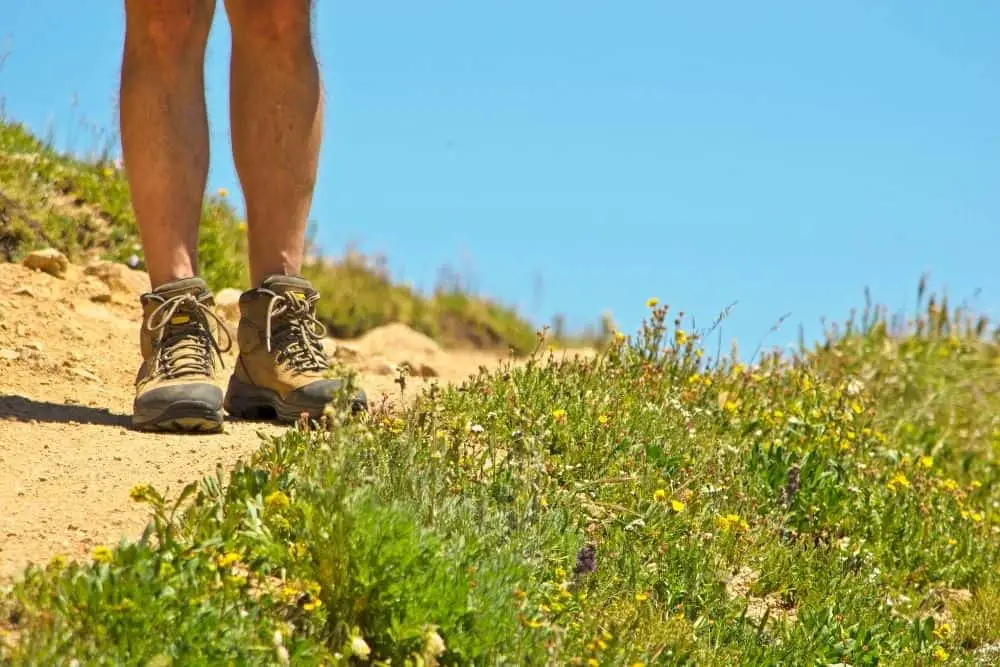
Proper maintenance and storage of your boots will lower the chance of squeaking. Fix any loose ends as quickly as possible.
One area that you should pay more attention to in this regard is the sole. Examine the soles regularly and check for gaps between the heels.
Always know when you need to call in an expert to do the job for a small fee. Before doing this, you have to weigh your options correctly and know if you are better off returning them.
If your new boots have more than one problem right out of the box, there is no need to keep them, regardless of how much you love the design or how much of a killer you think the price is. Keeping them may cost you much more in the long run.











